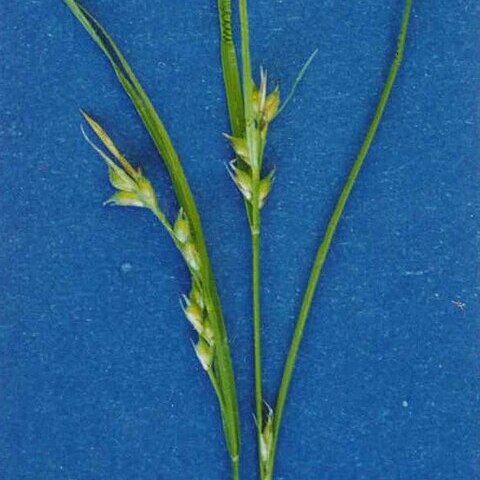Plants densely cespitose; rhizomes usually ascending, occasionally horizontally spreading, dark reddish brown to purplish brown, 0–10 mm, stout. Culms ascending, 7–30(–40) cm, weakly to strongly scabrous distally; bases (remnants of old leaves) slightly fibrous. Leaf blades pale to dark green, usually equaling or exceeding stems, occasionally shorter, 0.8–2.5(–4) mm wide, herbaceous, glabrous abaxially, strongly scabrous to papillose adaxially. Inflorescences with both staminate and pistillate spikes; peduncles of basal pistillate spikes erect, elongate, slender; peduncles of staminate spikes 1.1–10 mm; proximal nonbasal bracts leaflike, exceeding inflorescences. Spikes: proximal pistillate spikes 2–4 (basal spikes 1–2); cauline spikes overlapping or somewhat separated, with 3–10(–15) perigynia; staminate spikes (4.8–)6–12.8 × (0.7–) 0.9–1.3(–2.5) mm. Scales: pistillate scales pale to dark reddish brown, with narrow white margins, ovate, 2.9–5.7 × 1.4–2.3 mm, shorter than perigynia, apex acute or acuminate to long-acuminate; staminate scales lanceolate, 3.2–5.8 × 1.2–1.8 mm, apex acuminate. Anthers 1.2–2 mm. Perigynia green to pale brown, veinless, ellipsoid to obovoid, 3.1–4.5 × 1.4–1.7 mm; beak straight or slightly bent, pale green, occasionally with reddish brown tinge, 0.9–1.7 mm, ciliate-serrulate, apical teeth 0.2–0.4 mm. Stigmas 3. Achenes brown, globose to obovoid or ellipsoid, obtusely trigonous in cross section, 1.9–2.4 × 1.3–1.7 mm. 2n = 36.
More
Much like no. 101 [Carex deflexa Hornem.], but more densely cespitose, without creeping rhizomes; stems 1–3 dm; staminate spike longer, 5–12(–15) mm; perigynium 3–4.5 mm, its beak 1–1.7 mm, half to fully as long as the body, often strongly bidentate with teeth to 0.6 mm; 2n=36. Dry, rocky, exposed places; Yukon to Calif. and Colo., e. irregularly to Minn. and to Keweenaw Point, Mich.
Moist or dry, sandy or rocky, open montane pine, fir, and spruce woodlands, sagebrush slopes, deciduous wooded slopes, prairies, alpine meadows; at elevations from 210-3,700 metres.


